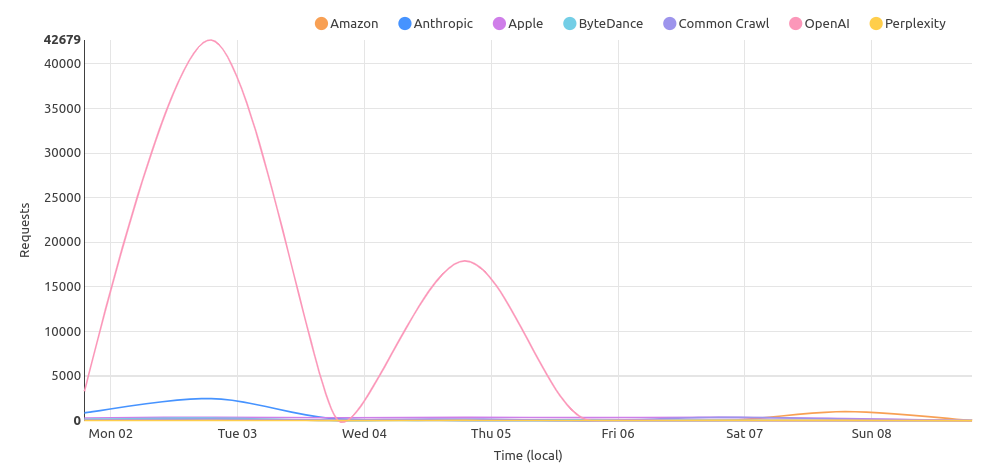Understanding the AI Audit Beta on Cloudflare
| filed under: Applebot visibility, Cloudflare AI Audit, AI-driven rankings, GPTBot SEO, AI crawlers, ClaudeBot traffic, Bytespider indexing, Optimize for bots, AI website optimization, Amazonbot SEOYou can hire Chris Abraham right now via his freelancer page on Upwork or set up a 30-minute call with him via Calendly.
As the digital landscape continues to evolve, artificial intelligence plays a more dominant role in how websites are discovered, indexed, and prioritized by search engines and platforms. For those looking to stay ahead, understanding how AI interacts with your site is no longer optional—it’s essential.
Imagine being able to peek behind the curtain and see how AI crawlers, bots, and algorithms engage with your website in real time. This is exactly what Cloudflare’s AI Audit Beta offers. For site owners like you, tools like these are game-changers. They not only reveal how various AI providers are analyzing your site but also give actionable insights into optimizing your content, infrastructure, and strategy to appeal to these powerful automated systems.
In this post, we’ll take an in-depth look at the AI Audit Beta for chrisabraham.com, demystify the key metrics, and explain what it all means for your website's visibility, performance, and success. We’ll explore the fascinating world of AI bots—what they are, what they’re looking for, and how they contribute to shaping your online brand’s destiny. By the end, you’ll have a clear roadmap for making your website irresistible to the growing number of AI systems that influence everything from search rankings to user recommendations.
Let’s dive in!
What is the AI Audit Beta?

Cloudflare’s AI Audit Beta allows website owners to monitor and manage how AI crawlers and bots access their sites. This is particularly useful in ensuring your content is accessible and optimized for AI systems, which increasingly influence search results, content recommendations, and user interactions.
Key Metrics from the AI Audit for chrisabraham.com
Here’s a breakdown of how different AI bots interact with your site:
| Bot | Provider | Type | Requests |
|---|---|---|---|
| GPTBot | OpenAI | AI Crawler | 175,722 |
| ClaudeBot | Anthropic | AI Crawler | 3,527 |
| Applebot | Apple | AI Crawler | 2,313 |
| Amazonbot | Amazon | AI Search | 1,544 |
| Bytespider | ByteDance | AI Crawler | 1,327 |
| CCBot | Common Crawl | Archiver | 1,153 |
| ChatGPT-User | OpenAI | AI Assistant | 406 |
| PerplexityBot | Perplexity | AI Search | 90 |
| OAI-SearchBot | OpenAI | AI Search | 37 |
Understanding the Providers and Their Roles

-
GPTBot by OpenAI
GPTBot leads in traffic, emphasizing the growing influence of OpenAI's models in crawling and indexing content. This bot gathers data to improve language models like ChatGPT. -
ClaudeBot by Anthropic
Anthropic’s ClaudeBot focuses on AI model training, emphasizing ethical and context-aware language processing. -
Applebot by Apple
This bot ensures compatibility with Apple’s ecosystem, optimizing content for Siri, Spotlight, and other Apple services. -
Amazonbot by Amazon
Amazonbot supports product search optimization and content analysis for its vast e-commerce platform. -
Bytespider by ByteDance
Primarily associated with TikTok, Bytespider analyzes content for discoverability on video platforms. -
CCBot by Common Crawl
This archival bot indexes public web content for open data and AI training datasets. -
ChatGPT-User and OAI-SearchBot by OpenAI
These bots interact dynamically with the site, emphasizing conversational AI and advanced search capabilities. -
PerplexityBot by Perplexity
Specializes in AI-driven search and question-answering capabilities.
Making Your Website Appealing to AI Bots

To ensure your website is optimized for these bots:
-
SEO and Content Optimization
- Structured Data: Use schema markup to help AI bots understand your site’s content.
- Meta Tags: Ensure clear and descriptive meta titles and descriptions.
- Keyword Strategy: Align content with keywords AI bots commonly associate with your industry.
-
Technical Accessibility
- Sitemaps: Keep your XML sitemap up-to-date for easier indexing.
- Robots.txt: Allow access to non-sensitive areas for better crawling.
- Load Speed: Optimize for fast loading, as bots prioritize performance.
-
User Experience
- Ensure clear navigation and a responsive design.
- Reduce unnecessary redirects or error pages.
-
Security and Compliance
- Use SSL certificates and maintain compliance with data protection laws.
- Avoid CAPTCHA configurations that block legitimate AI bots.
Interpreting AI Access and Its Implications
The AI access logs show not just activity but also intent:
- High Activity (e.g., GPTBot): Indicates your content is valuable for AI training.
- Moderate Activity (e.g., Applebot, Amazonbot): Suggests specific use cases, like product search or device compatibility.
- Low Activity (e.g., PerplexityBot): May highlight opportunities to improve discoverability in niche applications.
Increased interaction by these bots typically correlates with improved search rankings, better recommendations, and broader content reach. Monitoring these metrics ensures your brand remains visible in an AI-driven digital landscape.
Conclusion: The Future of AI-Optimized Websites
The AI Audit Beta for chrisabraham.com demonstrates the importance of catering to AI bots and algorithms. By understanding what they seek and optimizing accordingly, you can position your website as a hub for AI interaction, enhancing its visibility, accessibility, and overall desirability in an increasingly automated and algorithm-driven world.
Invest in consistent updates, keep an eye on your metrics, and make informed decisions to stay ahead of the curve!
You can hire Chris Abraham right now via his freelancer page on Upwork or set up a 30-minute call with him via Calendly.

